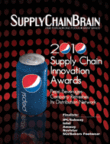
Visit Our Sponsors |
|
|
|
|
|
|
|
|
|
|
|
|
|
|
|
|
|
|
|
|
|
|
|
|
|
|
|
|
|
|
|
|
|
|
|
|
|
|
|
|

The dedicated cooperative has one customer and "11,000 bosses." The story of how IPC succeeded in making the Subway supply chain significantly leaner and greener.
On paper, Independent Cooperative Inc. (IPC) has one customer: the Subway restaurant chain. In reality, it serves many masters.
Subway is, after all, a franchise operation, and IPC is the independently owned purchasing cooperative that services its 32,000 stores. "I have 11,000 bosses," says IPC president and chief executive officer Jan Risi. "And every single one of them has my cell-phone number."
Innovation is key to Subway's success. In 2008, the chain scored a hit with its $5 foot-long sandwich promotion. But new ideas are also essential to the workings of the company's supply chain.
Risi and her team saw an opportunity to drive improved efficiencies in the way IPC supplied the stores - and, not incidentally, to create a more sustainable operation. So the company put together a strategic plan that would scrutinize every step of the process.
IPC faces a number of challenges in supplying the franchisees, according to vice president of purchasing Dennis Clabby. The meat, bread and other ingredients that go into Subway sandwiches are highly perishable, often requiring temperature-controlled transportation. As a result, speed is always of the essence. And the rapid growth of stores in the chain - the number nearly tripled between 1995 and 2009 - makes it tough to keep pace with orders.
Among the goals of the strategic plan were a greater reliance on cost-efficient truckload transport and faster inventory turns. Early on, IPC asked transportation services provider C.H. Robinson Worldwide Inc. for help in analyzing the dry distribution network. The exercise led to the consolidation of multi-SKU shipments of dry products, to reduce the number of less-than-truckload (LTL) moves.
Drawing on the example of Southwest Sanitation, a Dallas-based vendor, IPC began using new redistribution methods for its faster-moving refrigerated products. Up to then, vendors of protein products had been making the items in one place, shipping them to inventory, then moving them to the distribution center. Each stage made it harder for the carrier to maintain a constant temperature, reducing product shelf life.
IPC turned to two vendors, West Liberty Foods and Millard Refrigerated Services, for help in creating a redistribution system and new cold consolidation facility in Iowa. At the co-managed site, WLF operates 24 separate "operating rooms" for slicing. In an attached warehouse, Millard palletizes, shrink-wraps and stores product before it is shipped to the distribution centers. For outbound shipments, the company again looked to C.H. Robinson to make exclusive use of truckload transport.
In the process, says Clabby, IPC has increased inventory turns, prevented the cross-contamination of meats between slicing lines and boosted the freshness of product. "Proteins" are now 66 percent fresher when they reach Subway restaurants, according to IPC.
Packaging was another target of the efficiency effort. Once again, a strong vendor partnership was called for. At the suggestion of C.H. Robinson, IPC began working with Select Product Group (SPG), a supplier of packaging and paper, to create a highly automated regional distribution center. IPC was able to cut the number of individual items shipped to DCs from 160 to 12, even as it boosted the number of truckloads for outbound moves.
IPC discovered that 32 percent of its trucking capacity was going unutilized. By adding lightweight items such as straws and napkins, it was able to cube out the loads and bring an end to the shipping of air.
The third source of innovation for IPC and Subway lay in the production and shipping of bread. Rapid growth in the number of stores was putting a strain on the old system, with bakeries running at 110-percent capacity in the summer months. IPC knew it had to add bread plants; the only question was where. Working with C.H. Robinson, the company analyzed the location of its current plants and DCs, devising multiple "what-if" scenarios to come up with the most efficient network and lowest landed cost.
One new bread plant in Tolleson, Ariz., operated by Southwest Baking, deployed state-of-the-art, fully automated systems to allow for increased production and greater flexibility in volumes. Other facilities were built in Austin, Tex., Columbia, S.C. and Centralia, Wash. The new network, with plants closer to the source, allowed Subway's vendors to double the efficiency of bread-line capacity while improving product quality, Clabby says. IPC and C.H. Robinson reevaluate the bread-sourcing plan each year, taking into account changes in manufacturing costs, bakery capacity, volume commitments, market demand and cost per case.
IPC works closely with Subway's marketing and product-development managers to support new demand. The $5 foot-long promotion, for example, led to a 20-percent increase in sales. That caused a 48-percent rise in bread usage during the promotional period, along with an additional 700,000 cases of product being delivered to the stores each week.
Also involved in the detailed analysis of Subway's distribution network were experts from MIT and Chainalytics. Their insights and encouragement gave IPC the impetus to work more closely with Subway's manufacturers, who in turn could go to their banks for the necessary capital, Clabby says. The task of transportation management fell to C.H. Robinson, which hired one of its divisions, Transportation Management Center, to oversee related business processes and data management.
Sustainability remains a key concern of IPC and Subway. (Another of Chainalytics' responsibilities was to measure the company's North American carbon footprint, from the standpoint of transportation and distribution.) Annual environmental savings resulting from the initiative included 4.6 million pounds of plastic, 14.1 million gallons of gasoline, 115 million gallons of water, 9.9 million pounds of corrugated cardboard and 18.6 million kilowatts of electricity.
The company's bottom line was positively affected as well. Between 1997 and 2009, Risi estimates, IPC realized more than $1bn in cumulative cost savings.
The company continues to work on best practices for improving profitability while creating a more sustainable supply chain. The North American unit has joined with the five other global IPCs under the name of Unaterra ("One Earth"), with the goal of streamlining supply chains on a worldwide basis.
Resource Links:
C.H. Robinson, www.chrobinson.com
Chainalytics, www.chainalytics.com
RELATED CONTENT
RELATED VIDEOS
Timely, incisive articles delivered directly to your inbox.







